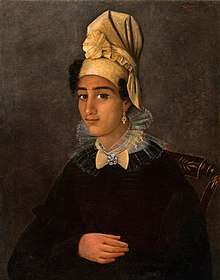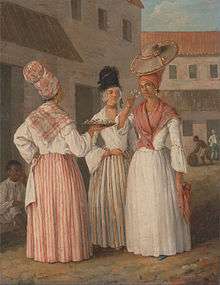Tignon
A tignon (also spelled and pronounced tiyon) is a type of headcovering. A large piece of material tied or wrapped around the head to form a kind of turban that somewhat resembles the West African Gele. It was worn by Creole women of African descent in Louisiana beginning in the Spanish colonial period, and continuing to a lesser extent to the present day.


Tignon Law
This headdress was the result of sumptuary laws passed in 1786 under the administration of Governor Esteban Rodriguez Miró. Called the tignon laws, they prescribed and enforced oppressive public dress for female gens de couleur in colonial society.
Historian Virginia M. Gould notes that Miró hoped the law would control women “who had become too light skinned or who dressed too elegantly, or who, in reality, competed too freely with white women for status and thus threatened the social order.”[2]
Afro-Créole protest
Miró's intent of having the tignon mark inferiority had a somewhat different effect, according to historian Carolyn Long[3] who noted: "Instead of being considered a badge of dishonor, the tignon…became a fashion statement. The bright reds, blues, and yellows of the scarves, and the imaginative wrapping techniques employed by their wearers, are said to have enhanced the beauty of the women of color."
The women who were targets of this decree were inventive and imaginative. They decorated tignons with their jewels and ribbons, and used the finest available materials to wrap their hair. In other words, "[t]hey effectively re-interpreted the law without technically breaking the law"[4]—and they continued to be pursued by men.
Legacy
Using that scholarship, historian Fernin F. Eaton, a Louisiana native, suggests sagging may be an ironic and modern twist on that defiant Afro-Créole women's protest movement. Eaton opines that while Miró's 1786 edict singled out women for acting "too white," a modern-day version of sumptuary law, i.e., efforts to prohibit the practice of saggin', arguably singles out (largely) black males for not acting "white enough."[5] Saggin' may evidence a continuation of that Afro-Créole defiance, in recognition that African-American males, especially in Louisiana,[6] are disproportionately incarcerated.[7]
Tignons past and present
The tignon can be wrapped in many ways, and it was and is worn in a different way by every woman. Madras was a popular fabric for tignons among both free and enslaved populations, and has become iconic. Tignons were often created out of mis-matched scraps of undyed fabric given to slaves by their masters. The patchwork of material was made to appear festive. Tignons worn by free women of color or enslaved women in Martinique, Guadeloupe, St. Lucia and Dominica , was made from Madras fabric, even had hidden messages.[8]
The tignon is experiencing a revival in Louisiana. It is found particularly in Creole-themed weddings. Celebrities such as Erykah Badu and Jill Scott continue to wear headdresses, as a celebration of Afro-American culture.
See also
Notes
- http://collections.britishart.yale.edu/vufind/Record/1670107
- "A Chaos of Iniquity and Discord: Slave and Free Women of Color in the Spanish Ports of New Orleans, Mobile, and Pensacola.”." The Devil’s Lane: Sex and Race in the Early South (1997): 232-246, at p. 237
- Long, Carolyn Morrow. A New Orleans Voudou Priestess: The Legend and Reality of Marie Laveau. University Press of Florida, 2006, at p. 21
- NPS Ethnography: African American Heritage & Ethnography
- Hume, Hobbes and the Hood(ies), or Saggin' in the 1700s, paper delivered by Fernin F. Eaton to Conference, Revolutions in Eighteenth-Century Sociability, Montréal, 15-18 Oct. 2014 https://www.academia.edu/8921539/Hume_Hobbes_and_the_Hood_ies_or_Saggin_in_the_1700s
- http://www.bjs.gov/content/pub/pdf/p13.pdf
- Alexander, Michelle. The New Jim Crow: Mass incarceration in the age of colorblindness. The New Press, 2012.
- The Tignon and Women of Color in Old New Orleans, African American Resource Center, New Orleans Public Library